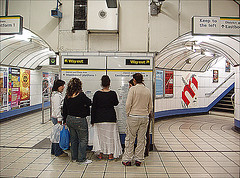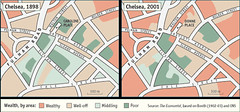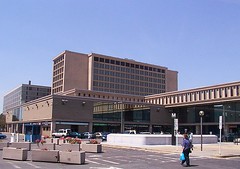(I don't? want to go to) Chelsea*
 London Underground photo by Flickr member Karin Cameron.
London Underground photo by Flickr member Karin Cameron.I suppose to "internationalize"/"internationalise" this blog I should use the keyword term "urban-revitalization-regeneration", since the Brits especially use the term "urban regeneration." As I have said many times, because decay set in earlier in the UK's center cities than in the U.S., the UK got a head start on us, and the UK is doing some interesting work and writing on these issues.
Especially because as a government, the British system is much more connected to local places--the country is smaller, Members of Parliament serve as ministers in the government, and the average MP represents fewer than 90,000 citizens. (Contrast this to the U.S. where members of the House of Representatives represent almost 700,000 constitutents on average.)
Andrew Salzberg is a young lad of Dutch and American extraction, living in the Netherlands, and he wants to call our attention to a recent article in The Economist looking at changes in the Chelsea area of London over the last 100 odd years. The article, "There goes the neighbourhood," compares 2000 census data to a study from 1898, which color-coded blocks on a seven point scale according to their social makeup.
 Chelsea, London, SES composition, 1898 vs. 2001. Image from the Economist. Click on the Economist article for a larger version.
Chelsea, London, SES composition, 1898 vs. 2001. Image from the Economist. Click on the Economist article for a larger version.[Note that I have argued that the DC Office of Planning neighborhood categorization of healthy, transitioning, emerging, and distressed can be performed on a block-by-block basis in order to better target public policy and regulations to bring about more successful results.]
Some things have changed, some areas much better. In fact it reminds me of what I say about SW DC, that had the houses remained there, these days they'd be worth upwards of $1 million each. Instead it's time to "renew" the urban renewal, and SW has a pretty barren feel, at least to me.
 Shulman Market, SW DC late 1930s. FSA photo by Louise Rosskam, Library of Congress collection.
Shulman Market, SW DC late 1930s. FSA photo by Louise Rosskam, Library of Congress collection. Waterfront Mall, SW DC. Photo by Dan Malouff.
Waterfront Mall, SW DC. Photo by Dan Malouff.______________
(I Don't Want to Go To) Chelsea by Elvis Costello.
Index Keywords: urban-revitalization



1 Comments:
Thank you so much for providing the data you need, and thank you for sharing.
Post a Comment
<< Home